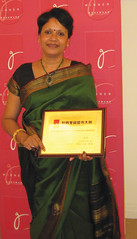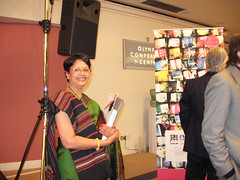 Jennifer Kumar
Jennifer Kumar
photos submitted by Viji Varadarajan
I would need to live three or more lifetimes just to experience the full range of amazing vegetarian food options in Tamil –South Indian cooking. However, with the aid of Viji Varadarajan’s Cookbook, Samayal: The Pleasures of South Indian Vegetarian Cooking, I can learn at least the Tamil Brahmin, or Tambram, cuisine spiced with few other regional dishes in one lifetime- whew! (In London at the Olypmpia Theatre for the awards, right.)
Having myself lived in Tamil Nadu for two years, and living in the homes of Tamil Brahmins, these cookbooks bring back so many homely memories of my stay there. Though I stayed in the homes of Tamil Brahmins day in and out, shared meals on the floor or at the table, learning to eat with only my right hand, and picking up my drinking glass (steel tumbler) with my left, relishing to the last grain of annam (rice), I regret whole-heartedly not entering kitchens and learning to cook when I was there. This is where Viji’s books fill the gap. I feel as though she is my Tamil Amma, taking me under her wing in her family kitchen and guiding me through generations of her family’s culinary secrets.
Viewing almost 120 recipes in the table of contents*, the main concern I have in opening up the book is in deciding where to start- all items tempt my tastebuds and I become overwhelmed with what to try first. Should I try the recipes I already know, like ven pongal (rice and moong dhal porridge) or one I may not know like keerai sundal (dry fried spinach salad)? When I was in India, I was so busy devouring the dishes that I never bothered asking the names, so this book again fills in the gaps there, too! So many choices and so little time.
A Range of Tastes
Opening up this book, I felt like ‘a kid in a candy store’- so many tempting choices moving me in different directions. There are some areas of the book that may be suitable places to start for the novice, and as luck has it the first chapter featuring over 13 varieties of rice dishes is it!
My favorites are lemon rice, tomato rice and curd or yogurt rice (thayyir saadham ). I have chosen these few recipes because they have the fewest steps and methods of preparation, and after a few successful attempts, I can make these dishes with my eyes closed! These dishes have been presented using fresh rice, but if you have left over rice and don’t know what to do with it- warm it and add the rest of the fresh tempered ingredients for a quick snack.
In Indian and Tamil menu preparation, nothing is served alone. Along with tomato and lemon rice, one could try any of the three varieties of coconut chutney, with my recommendation for beginners on the thengai thovayal because it has fewer ingredients. Some may shy away from this one because of lack of tamarind or asafetida. No worries, if you cannot find this in your local area, omit and make. Yes, the taste will differ, but overall, you will have nice coconut chutney to tempt one’s taste buds. I personally have made this recipe both ways, each equally tasty. If you’d like to try two chutneys with the lemon rice, in addition to coconut, try tomato. The recipe for Thakkaali Vengaaya Thovayal has a few more steps, providing a more layered taste to chutney. As for the curd rice, generally a more spicy or crunchy accompaniment is well-suited; such as an easier-to-prepare urulai kizhangu vadhakal – a crispy potato roast (which if you eat eggs, is a nice replacement for bland breakfast potatoes), or a more advanced preparation of sutta kathirikkai kotsu- a slightly pungent gravy with grilled eggplant. The best way to eat the accompaniments is by taking small amounts along with a larger amount of the main mixed rice dish.
Once you make these accompaniments, other menu items become more tempting. A high protein choice that is good as a snack or breakfast item is pesarat- the moong dhal pancake. I have made this with either split moong (yellow) or whole moong (green) with or without rice. This will go well with any chutney or even dipped in a sambar (thick vegetable lentil stew).
Have more left over coconut chutney? Try your hand at the famous rava uppuma- a breakfast or snack item made of rava (cream of wheat) infused with vegetables and spices. This is one of our personal household favorites. One can substitute other ingredients for cream of wheat- making different varieties of uppuma as featured in the book. Last, but never least, is the famous masaal dosai. This ‘Indian Burrito’ is a favorite of Indians and non-Indians alike. This crispy lentil and rice pancake is stuffed with a spicy potato fry similar to the urulai kizhangu vadhakal above. This dish, however simple it looks, has several steps. One should plan to create this dish over a few days time, as the rice and lentils used to make the pancake are first soaked for up to eight hours, ground into a velvety batter, and left to ferment for up to more than a day depending on your climate. The trick to a good tasting dosa is the sourness of the batter. This batter can also be used for making steamed-cakes or idlis, which can also be eaten with any variety of chutney or spice powders mixed with ghee, sesame or vegetable oils. Viji has shared three spice powder recipes suitable for dosa – idli accompaniments- karuveppalai podi, kothamalli podi, and idli-dosai milagai podi; sometimes affectionately known as ‘gunpowder’. The sambhar podi is one of the most versatile in a tambram kitchen. Used in a variety of different dishes - chutneys, stir fried vegetables and in gravies, it gives a distinct flavor to each dish. Amazingly no one dish tastes the same as the vegetables are cooked in its own juices.
If you’re looking for a snack on the run- a popular finger food snack is kothu kadalai sundal. This chick pea fried snack is sold on street sides in Chennai in small funnels. This is a fun snack to take on the run because it’s good even if it’s cold (though always better hot!). A Navarathri favorite among some in Chennai, this is a unique snack that can be a party pleaser because of it’s unique look and taste. Kids seem to love it too!
 No book on Indian cookery can be complete without a section on sweets. Who can resist a good rice pudding, called paal payasam in Tamil (literally meaning Milk Pudding). This sweet treat is easy to make in a pinch because it only has four ingredients- cream, sugar, rice and ghee (clarified butter) which are readily available almost anywhere! If you can’t find ghee in your area, Viji has offered a method of preparation for this in the book too! Another favorite sweet dish of mine is sakkarai pongal, a sweet version of ven pongal, a rice and moong dhal porridge. (photo: The author holding her award plaque.)
No book on Indian cookery can be complete without a section on sweets. Who can resist a good rice pudding, called paal payasam in Tamil (literally meaning Milk Pudding). This sweet treat is easy to make in a pinch because it only has four ingredients- cream, sugar, rice and ghee (clarified butter) which are readily available almost anywhere! If you can’t find ghee in your area, Viji has offered a method of preparation for this in the book too! Another favorite sweet dish of mine is sakkarai pongal, a sweet version of ven pongal, a rice and moong dhal porridge. (photo: The author holding her award plaque.)
Limiting this review to such few recipes seems a shame. To get your hands on and into these recipes, order Viji’s book today through Amazon. Beside the recipes, you will learn about Indian culture and culinary tips at the end of each recipe. Ingredients that may be unfamiliar are listed in a pictorial in the back of the book. Viji has also created almost 20 menu plans for those wondering how to pair dishes into a complete meal. The book is then topped off with a selection of health drinks one can refresh them with after completing their wonderful, tasty, TamBram meals!
Thank you for sharing your culinary wisdom with us, Viji. I hope you enjoy her cookbook as much as I do!
*See the table of contents at Amazon.
**Special Thanks to Laura Denkatesh, Cookbook Coach for giving tips on writing a good cookbook book review! See Laura’s Website.
Related links/Articles
Viji’s website- Viji Samayal
Join Viji's fan page at Facebook
Insights and Inspirations of Viji Varadarajan (My interview with Viji)
Want to see Yogurt from a different perspective? (My review of Viji’s cookbook, A Healthy Taste of Indian Culture: Cooking with Yoghurt)
Newspaper/Magazine Articles
Brahmin Recipes by Viji Varadarajan on Magic Chef Hat, October 2008
Fusion in the Kitchen – The Hindu, March 2009
The tradition continues – Harmony Magazine, September 2007
tags : "cookbook authors", "south indian food", "tamil brahmin", "tamil food", "vegetarian samayal", traditional cookery "indian cooking" vegetarian "Indian vegetarian cooking" "pure vegetarian cookery" “cookbook reviews”



